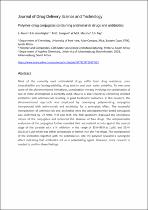JavaScript is disabled for your browser. Some features of this site may not work without it.
- ResearchSpace
- →
- Research Publications/Outputs
- →
- Journal Articles
- →
- View Item
| dc.contributor.author |
Alven, S

|
|
| dc.contributor.author |
Aderibigbe, BA

|
|
| dc.contributor.author |
Balogun, Mohammed O

|
|
| dc.contributor.author |
Matshe, William MR

|
|
| dc.contributor.author |
Ray, Suprakas S

|
|
| dc.date.accessioned | 2019-08-28T07:32:39Z | |
| dc.date.available | 2019-08-28T07:32:39Z | |
| dc.date.issued | 2019-10 | |
| dc.identifier.citation | Alven, S., Aderibigbe, B.A., Balogun, M.O., Matshe, W.M. & Ray, S.S. 2019. Polymer-drug conjugates containing antimalarial drugs and antibiotics. Journal of Drug Delivery Science and Technology, Vol, 53, pp. 1-12. | en_US |
| dc.identifier.issn | 1773-2247 | |
| dc.identifier.uri | https://doi.org/10.1016/j.jddst.2019.101171 | |
| dc.identifier.uri | https://www.sciencedirect.com/science/article/pii/S1773224719307622 | |
| dc.identifier.uri | http://hdl.handle.net/10204/11109 | |
| dc.description | Copyright: 2019 Elsevier. Due to copyright restrictions, the attached PDF file contains the abstract version of the full-text item. For access to the full-text item, please consult the publisher's website. The definitive version of the work is published in the Journal of Drug Delivery Science and Technology, Vol, 53, pp. 1-12. https://doi.org/10.1016/j.jddst.2019.101171 | en_US |
| dc.description.abstract | Most of the currently used antimalarial drugs suffer from drug resistance, poor bioavailability and biodegradability, drug toxicity and poor water solubility. To overcome some of the aforementioned limitations, combination therapy involving the combination of two or more antimalarials is currently used. Malaria is also treated by combining selected antibiotics with antimalarials resulting in good treatment outcomes. In this research, the aforementioned approach was employed by developing polymer-drug conjugates incorporated with antimalarials and antibiotics for a synergistic effect. The successful incorporation of antimalarials and antibiotics onto the polyaspartamide-based conjugates was confirmed by 1H NMR, FTIR and SEM. The XRD spectrums displayed the amorphous nature of the conjugates and indicated the absence of free drugs. The antiplasmodial evaluation of the conjugates further revealed their antimalarial activity against the asexual stage of the parasite with a % inhibition in the range of 35.6–99.9 at 1 μM, and 55.4–100.8 at 5 μM which was either comparable or better than the free drugs. The incorporation of the antibiotics together with the antimalarials into the polymer revealed a synergistic effect indicating that antibiotics act as a potentiating agent. However, more research is needed to confirm these findings. | en_US |
| dc.language.iso | en | en_US |
| dc.publisher | Elsevier | en_US |
| dc.relation.ispartofseries | Workflow;22624 | |
| dc.subject | Antimalarials | en_US |
| dc.subject | Combination therapy | en_US |
| dc.subject | Polymer-drug conjugates | en_US |
| dc.subject | Primaquine | en_US |
| dc.subject | Sulfadoxine | en_US |
| dc.subject | Pyrimethamine | en_US |
| dc.subject | 4-Aminosalicylic acid | en_US |
| dc.title | Polymer-drug conjugates containing antimalarial drugs and antibiotics | en_US |
| dc.type | Article | en_US |
| dc.identifier.apacitation | Alven, S., Aderibigbe, B., Balogun, M. O., Matshe, W. M., & Ray, S. S. (2019). Polymer-drug conjugates containing antimalarial drugs and antibiotics. http://hdl.handle.net/10204/11109 | en_ZA |
| dc.identifier.chicagocitation | Alven, S, BA Aderibigbe, Mohammed O Balogun, William MR Matshe, and Suprakas S Ray "Polymer-drug conjugates containing antimalarial drugs and antibiotics." (2019) http://hdl.handle.net/10204/11109 | en_ZA |
| dc.identifier.vancouvercitation | Alven S, Aderibigbe B, Balogun MO, Matshe WM, Ray SS. Polymer-drug conjugates containing antimalarial drugs and antibiotics. 2019; http://hdl.handle.net/10204/11109. | en_ZA |
| dc.identifier.ris | TY - Article AU - Alven, S AU - Aderibigbe, BA AU - Balogun, Mohammed O AU - Matshe, William MR AU - Ray, Suprakas S AB - Most of the currently used antimalarial drugs suffer from drug resistance, poor bioavailability and biodegradability, drug toxicity and poor water solubility. To overcome some of the aforementioned limitations, combination therapy involving the combination of two or more antimalarials is currently used. Malaria is also treated by combining selected antibiotics with antimalarials resulting in good treatment outcomes. In this research, the aforementioned approach was employed by developing polymer-drug conjugates incorporated with antimalarials and antibiotics for a synergistic effect. The successful incorporation of antimalarials and antibiotics onto the polyaspartamide-based conjugates was confirmed by 1H NMR, FTIR and SEM. The XRD spectrums displayed the amorphous nature of the conjugates and indicated the absence of free drugs. The antiplasmodial evaluation of the conjugates further revealed their antimalarial activity against the asexual stage of the parasite with a % inhibition in the range of 35.6–99.9 at 1 μM, and 55.4–100.8 at 5 μM which was either comparable or better than the free drugs. The incorporation of the antibiotics together with the antimalarials into the polymer revealed a synergistic effect indicating that antibiotics act as a potentiating agent. However, more research is needed to confirm these findings. DA - 2019-10 DB - ResearchSpace DP - CSIR KW - Antimalarials KW - Combination therapy KW - Polymer-drug conjugates KW - Primaquine KW - Sulfadoxine KW - Pyrimethamine KW - 4-Aminosalicylic acid LK - https://researchspace.csir.co.za PY - 2019 SM - 1773-2247 T1 - Polymer-drug conjugates containing antimalarial drugs and antibiotics TI - Polymer-drug conjugates containing antimalarial drugs and antibiotics UR - http://hdl.handle.net/10204/11109 ER - | en_ZA |






